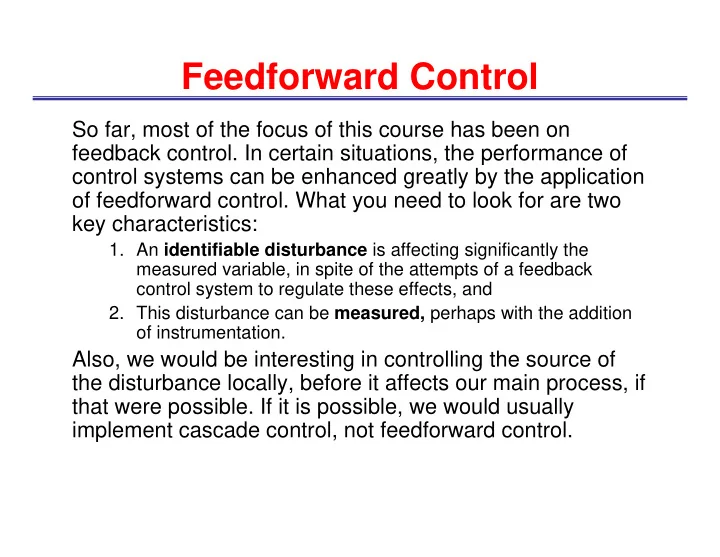

Feedforward Control So far, most of the focus of this course has been on feedback control. In certain situations, the performance of control systems can be enhanced greatly by the application of feedforward control. What you need to look for are two key characteristics: 1. An identifiable disturbance is affecting significantly the measured variable, in spite of the attempts of a feedback control system to regulate these effects, and 2. This disturbance can be measured, perhaps with the addition of instrumentation. Also, we would be interesting in controlling the source of the disturbance locally, before it affects our main process, if that were possible. If it is possible, we would usually implement cascade control, not feedforward control.
Examples of Feedforward Control • Shower – Hear toilet flush (measurement) – Adjust water to compensate – Feedback is when you wait for the water to turn hot before changing the setting • Car approaching hill – See how steep the hill is (measurement) – Push on pedal to keep steady speed – Feedback is to wait for slowing before adjusting pedal • Chemical system – Measure something in feed stream • like T water,return in heating plant – Change heat to reactor
Example Feedback control loop • Goal: Cool down hot water with cold water stream • Controlled & measured variable: T out • Manipulated variable: flow rate of hot stream (q hot )
Portion of Block Diagram D G D U Y + G P + How do we manipulate U(s) to cancel the effect that D(s) will have on Y(s)?
Derivation 1. Write an algebraic equation for the block diagram Y(s) = D(s) ⋅ G d (s) + U(s) ⋅ G p (s) 2. If Y(s) is to be unaffected by D(s), then we want Y(s) = 0 3. Solve for U(s) in terms of D(s) U(s) = [-G d (s)/G p (s)] ⋅ D(s) So G ff = -G d (s)/G p (s)
If G d and G p are first order − θ − θ s s ( ) K e K e p d ( ) = = p d G s G s τ + τ + d p s 1 s 1 p d Therefore, ⎛ − θ ⎞ s K e d ⎜ ⎟ dynamic d ⎜ ⎟ τ + τ + ( ) s ⎝ ⎠ s 1 s 1 ( ) K − θ − θ = − = − p d d G s e d p ⎛ − θ ⎞ τ + ff s K s 1 K e p ⎜ ⎟ p d p ⎜ ⎟ τ + s 1 ⎝ ⎠ K p = − d static K p
When is G ff not feasible? τ + ( ) s 1 s ( ) K − θ − θ = − p d G s e d p τ + ff 1 K s p d When θ p > θ d , the function will grow without bounds
Y Modify block diagram + + G P G D U G ff + + D
Feed Forward with Feedback Trim D G d Y d G ff ~ E Y sp Y U Y u Y P sp ++ K m + G c G P + G v - + Y m G m
Back to equipment diagram • Measure the disturbance (fluctuating cold water inlet flow rate) • Adjust controller through model (G ff )
Seborg’s version Figure 15.11
Disturbance Rejection Performance Disturbance Rejection Performance of Single Loop PI Controller Disturbance Rejection Performance of PI With Feed Forward constant set reactor exit point temperature constant set point rapid control action from feed forward disturbance disturbance variable steps variable steps Feedback (PI) Feedforward with Feedback (PI)
Practice − − 37 s 57 s ( ) 0 . 6 e ( ) 0 . 25 e = = G s G s + + d p 39 1 31 s 1 s K 0 . 25 = = d 0 . 417 K 0 . 60 p θ − θ = − = 57 37 20 d p + 39 s 1 = − − 20 s G 0 . 417 e + ff 31 s 1
Physically Realizable G ff 1. The exponential term must be negative θ p < θ d • 2. The order of the numerator must be less than or equal to that of the denominator ( )( )( ) + + + s 1 s 2 s 3 Physically unrealizable ( )( ) + + s 4 s 5 ( )( ) + + s 1 s 3 Physically realizable ( )( ) + + s 4 s 5 ( )( ) + + s 1 s 3 Physically realizable + + + 3 2 1 s s s
Comparison of Feedforward & Cascade Cascade Feedforward Sensors 2 2 Controllers 2 1 Valve 1 1 Model 0 1 t settling small for θ p < θ d Restrictions inner loop
Recommendation • Use cascade first • Use feedforward when – Disturbance can be isolated – There is no “inner loop” variable that responds to the manipulated variable – Cannot use the same valve to control the disturbance
Feed Forward vs Cascade Jacketed Reactor FeedForward with Feedback Cascade
Feed Forward vs Cascade Jacketed Reactor FeedForward with Feedback Cascade
Control Station Example Jacketed Reactor Volunteer needed
Recommend
More recommend